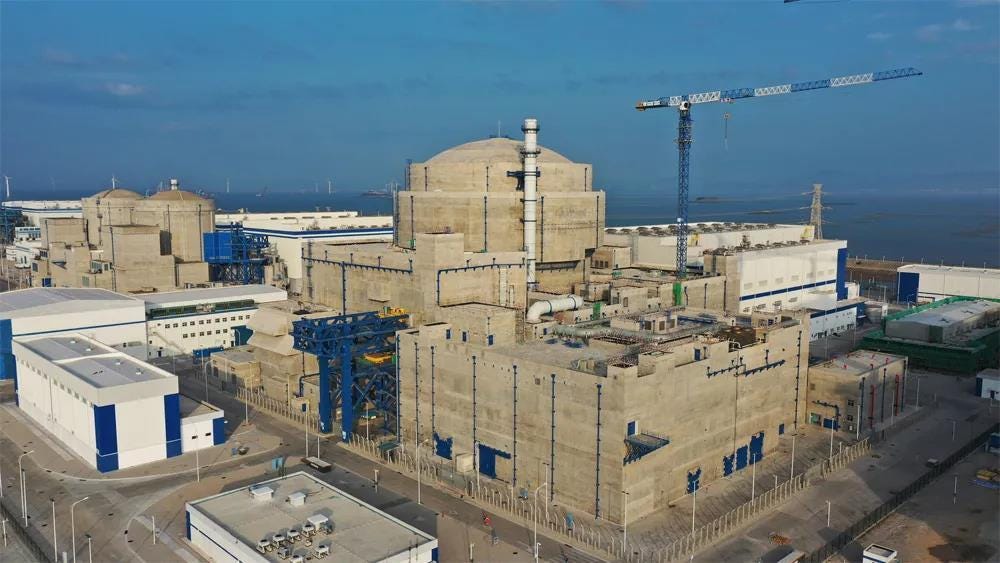Actuarial Examinations
Pete Hegseth to unstick US nuclear energy.
“A tactic that drags on too long becomes a drag.”—Saul Alinsky
President Dwight D. Eisenhower was the original driving force behind the creation of the US civilian nuclear power sector. The vast majority of the current fleet of 94 operating reactors in the country can be traced back to his personal leadership, beginning with the formation of the Atomic Energy Commission (AEC) in 1954. The AEC was charged with weapons development, safety regulations, and—critically—encouraging private investment in the peaceful uses of nuclear energy, especially for electric power. The subsequent two decades saw Eisenhower’s vision carried out with military discipline as the AEC partnered with industry to facilitate the construction of new reactors.
Ironically, things came to a grinding halt after the energy crisis of 1973. One might have expected the oil embargo to motivate the US to accelerate its civilian nuclear ambitions. Instead, the Energy Reorganization Act of 1974 effectively abolished the AEC and transferred regulatory oversight to the newly formed Nuclear Regulatory Commission (NRC). The NRC’s mandate was limited strictly to regulation and safety, while promotional objectives were deemphasized. It didn’t take long for the new regime to effectively halt new reactor construction in the country.
The main weapon of the NRC is the linear no-threshold (LNT) model—an unscientific ethos that treats all exposure to radiation, no matter how minute, as both dangerous and cumulative. In other words, there is no threshold below which otherwise insignificant exposures are considered harmless. Combined with the risk-averse bureaucrat mindset and you get this astonishing result: only two of the current fleet of US reactors were approved and built under the auspices of the NRC.
For anti-nuclear Malthusian environmentalists, the LNT model is ideal. It allows them to actively stunt the creation and distribution of energy abundance while shielding themselves behind the guise of safety and alleged expertise. Zero is an emotional number and when any amount of radiation is viewed as inherently bad, the complete absence of exposure is treated as inherently good, regardless of the positive tradeoffs foregone as a consequence.
For evidence, look no further than the medical industry where controlled radiation exposure can be incredibly powerful in treating sick patients. In diagnostics, radiation allows doctors to see inside the body with remarkable detail in a non-invasive manner. It is also used in various treatments, most commonly in the targeted destruction of cancer cells. Despite the medically beneficial attributes of radiation, its use in healthcare is greatly impeded by the LNT mindset. Patients arrive at clinics with unfounded fears that lead to avoidance of care. Excessive regulatory costs steer providers toward suboptimal treatment strategies that avoid radiation altogether. Innovation is stifled, as scientists and medical companies proactively avoid exploring the beneficial aspects of the technology. This is from a recent and scathing editorial published in The Journal of Nuclear Medicine last August:
“Had the scientific community not adhered to the LNT model but instead explored radiation hormesis in clinical trials when it was proposed in the 1980s by Luckey, adoption of radiation hormesis might have led to reduction in cancer deaths by around 20%. This would have translated to preventing nearly 2 million cancer deaths in 2022 alone, given the staggering global toll of 9.7 million cancer deaths that year. Thus, the decision of advisory bodies to persist with the LNT model, despite published evidence supporting radiation hormesis, may have contributed to millions of preventable cancer deaths over recent decades.”
Amid the flurry of executive actions undertaken in the early days of President Donald Trump’s second administration, hopeful signs are emerging that the US may finally discard the destructive LNT framework. LNT is wholly incompatible with both his US energy dominance agenda and the military’s desire to win the artificial intelligence (AI) race—and it is this second objective that may provide Trump with the legal cover needed to reverse five decades of deeply flawed policy. Let’s explore why and gauge the odds of success.
On February 18, Trump signed Executive Order 14215, titled Ensuring Accountability for All Agencies. The order begins by noting that the US Constitution vests all executive power in the President alone, who “in turn is regularly elected by and accountable to the American people.” It then outlines how independent agencies, including the NRC, have effectively usurped presidential authority and oversight:
“However, previous administrations have allowed so-called ‘independent regulatory agencies’ to operate with minimal Presidential supervision. These regulatory agencies currently exercise substantial executive authority without sufficient accountability to the President, and through him, to the American people. Moreover, these regulatory agencies have been permitted to promulgate significant regulations without review by the President.
These practices undermine such regulatory agencies' accountability to the American people and prevent a unified and coherent execution of Federal law. For the Federal Government to be truly accountable to the American people, officials who wield vast executive power must be supervised and controlled by the people's elected President.”
The expert class of do-gooders reacted to this order with predictable horror. Allison McFarlane, who was appointed to the NRC by former President Barack Obama in 2012 and became its chair in 2013, took to the pages of the Bulletin of the Atomic Scientists to sound the alarm:
“In the past, the president and Congress, which has oversight capacity on the regulators, stayed at arm’s length from the regulators’ decisions. This was meant to keep them isolated, ensuring their necessary independence from any outside interference. Trump’s executive order implies there are no longer independent regulators in the United States.
Independent regulators should not only be free from government and industry meddling; they also need to be adequately staffed with competent experts and have the budget to operate efficiently. They also need to be able to shut down facilities such as nuclear power plants that are not operating safely, according to regulations. To do this, they need government to support their independent decisions and rulemaking.”
Two weeks ago, drafts of potential follow-on orders building upon EO 14215 were leaked to various legacy media outlets, including The Washington Post and The New York Times. In The Washington Post, we learn that at least one of the drafts offers a clear diagnosis of the root cause of the country’s nuclear stagnation:
“The NRC does not view its duty as promoting safe, abundant nuclear energy with regulatory clarity, flexibility and speed but rather insulating Americans from the most remote risks without regard for the domestic or geopolitical costs of its risk aversion.”
For the clearest indication of Trump’s intent to radically accelerate the proper buildout of new reactors in the country, we turn to The New York Times:
“The draft orders say the United States has fallen behind China in expanding nuclear power and call for a ‘wholesale revision’ of federal safety regulations to make it easier to build new plants. They envision the Department of Defense taking a prominent role in ordering reactors and installing them on military bases.
They would also set a goal of quadrupling the size of the nation’s fleet of nuclear power plants, from nearly 100 gigawatts of electric capacity today to 400 gigawatts by 2050. One gigawatt is enough to power nearly 1 million homes…
One option under consideration would be to designate certain A.I. data centers as ‘defense critical infrastructure’ and allow them to be powered by reactors built on Department of Energy facilities, which may allow projects to avoid review by the Nuclear Regulatory Commission.”
The concept of building nuclear-powered data centers on military bases is—to state it frankly—brilliant. Presumably, Trump will lean heavily on the authority afforded to the president by the Defense Production Act, among other justifications. As we have long chronicled in these pages, China is much further along in the AI race than most believe. And not by coincidence, the country is also set to surpass the US in installed nuclear power capacity:
“China has approved plans for building 10 nuclear reactors for 200 billion yuan ($27.7 billion), putting the country on track to push its nuclear power generation capacity past the US to become the world's largest by 2030.”
For all the controversy surrounding the man and his approach to governing, if President Trump succeeds in reining in the NRC, eliminating the LNT model, and catalyzing the construction of dozens of new nuclear power reactors across the US, he will bequeath future generations of Americans a legacy on par with that of Eisenhower. Here’s to hoping he gets it done.
“♡” this piece unless you’re an expert do-gooder.









Thank you for what you are doing and saying. I have been working as an advanced nuclear technology analyst (Generation III+ & Generation IV non-water cooled reactor technology) for almost four years via the US Department of Commerce and every single thing you have said in this piece is true. I have also done global value chain analysis on green hydrogen, offshore & onshore wind, solar, battery energy storage systems at grid-scale and books on fossil fuels and nuclear is by far the safest, most regulated and only energy source that literally cleans up after itself. It's a stunning technology and the people I have met are some of the brightest, hardest working, most environmentally conscious individuals you could imagine. They are the smartest people in the room with a technology that can give electricity almost 100 percent of the time for upwards of 100 years. You are correct as I have heard you state (and I am paraphrasing) that if aliens came down to earth they would ask - "Why aren't using more nuclear power for electricity, medicine, cancer treatments, desalinization, hydrogen, process heat, district heat, steam, etc." On top of that nuclear power deeply impacts direct, indirect, and induced job growth, wages, taxes, and supply chains. Thank you, thank you, thank you for writing about this issue! Nuclear power is the only answer for high capacity baseload electrical generation with zero emissions.
I'd recommend everyone to read Michael Shellenberger's "Apocalypse Never" to get the true facts on nuclear and other areas that are consistently exagerrated or outright lied about. In Europe it's even worse, as it's obvious for anyone wishing to see,that the whole green movement that for decades have lead the anti-nuclear movement, especially in Germany, have been supported and financed by Russia. That's however a type of Russian intervention that seems to be fine in Brussels...